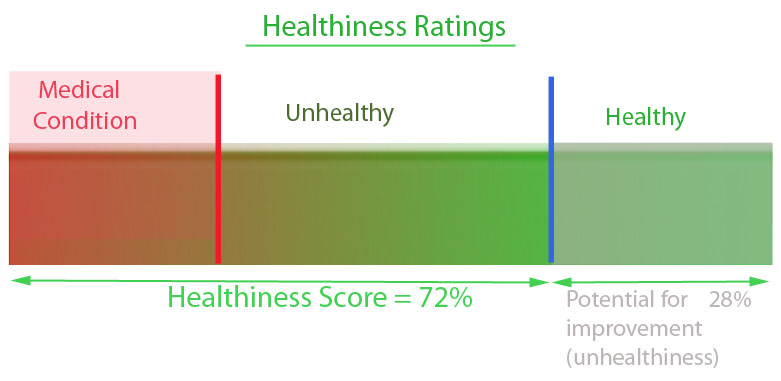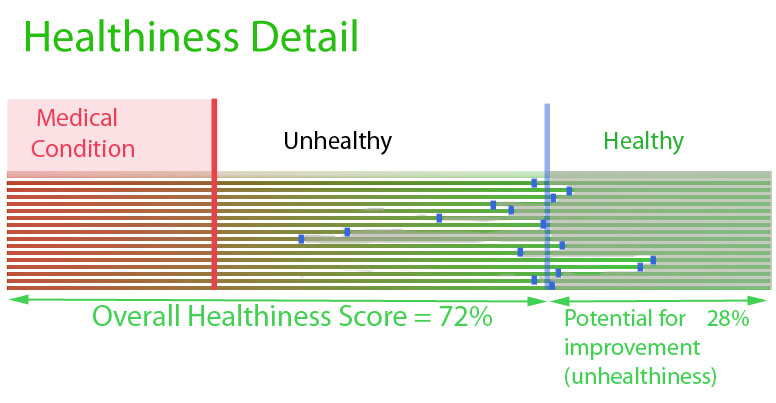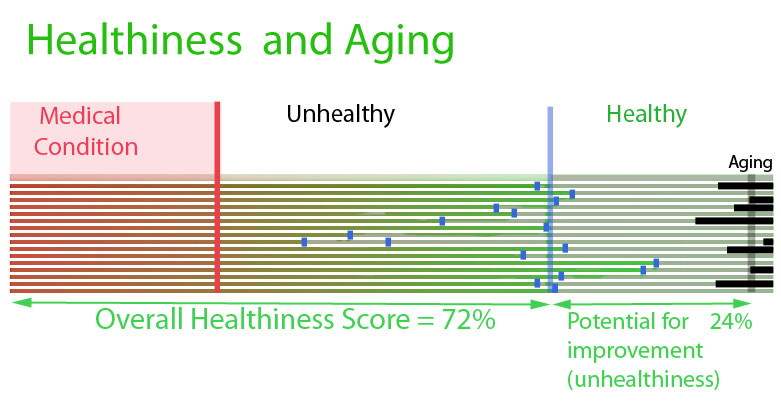What is aging?
As we grow from a baby to an adult, we grow larger, stronger, more able, and healthier. Then, gradually, slowly, we begin to grow smaller, weaker, and less healthy. We are ‘growing up’ in the first stage, and ‘aging’, or ‘growing old’, in the second stage.
What is ‘growing old’?
I’m working on a book about Healthicine. Blogging gives me opportunities to widen my thoughts, and explore my ideas, but it’s a poor platform for consolidation. I need time to gather all of my thoughts together, consolidate them into a book, and publish. As I work on the book, I find myself making interesting discoveries about health and healthicine. One of those discoveries is about aging. This blog post is a preview of some of the concepts in the upcoming book Healthicine: The Arts and Sciences of Health and Healthiness.
Once you reach your mid-30’s an onward, you might ask your doctor about some observations, symptoms, or feelings about your body, and be given the response “none of us are getting any younger”, or “you’re getting older, get used to it”.
Up to that age, health changes might have been viewed as illness or ‘unhealthiness’ (although our medical systems don’t use the word unhealthiness in any scientific fashion). Suddenly it has become aging.
What is the difference between unhealthiness and aging? Can your doctor tell the difference between unhealthiness and aging? No. Can the field of medicine distinguish between unhealthiness and aging? Not scientifically, not technically. The field of medicine studies illness in earnest, but knows little about healthiness.
Much of what we mistake for aging, is simply not aging. Some people seem to ‘age’ very quickly, or very early. Others age very slowly, or very late in life. They get older, but they still seem to be young in many ways.
The truth is – some people get very unhealthy at a relatively young age. Our medical systems don’t measure ‘healthiness’, so they can’t measure ‘unhealthiness’. It is difficult to distinguish between unhealthiness and aging.
As you get older, when you ‘lose healthiness’, our medical systems are more likely to call it ‘aging’.
You can get a facelift, or a Botox treatment. But many ‘youth’ medical treatments only make you ‘look younger’ while making you older – ‘less healthy’.
The word ‘aging’ is being used to cover up and dismiss many unhealthinesses. Unhealthinesses that our medical system consciously or not, chooses to ignore.
To understand this, first we need to understand healthiness and unhealthiness.
The Healthiness Ratings diagram shows our healthiness and unhealthiness. If we are alive, we are healthy. Our health score – the blue line, moves up and down as our health waxes and wanes. We always have some potential for improvement of our health, also known as our ‘unhealthiness’.
We don’t measure healthiness – so we have no idea what our scores are, what ranges are normal, nor how our healthiness changes as we grow older. But, whatever the score, you can fight unhealthiness. You can win against unhealthiness creating and improving your healthiness.
Unhealthiness can be turned back. ‘Old Age’ cannot. Unhealthiness can be changed.
The Healthiness Detail diagram gives a closer look. We have many different aspects of healthiness; genetic healthiness, circulatory system healthiness, skin healthiness and so on.
Healthiness is not a single score, it is consolidation of many healthiness scores, creating an overall score. We can see how individual healthiness ratings are gathered to create an overall rating. There are thousands of possible healthiness ratings – and we will not know which are the most important indicators of health until we study them in detail. When we improve our fitness, for example, we move one of the healthiness measures up, decreasing the level of unhealthiness in that measure, and increasing our overall healthiness.
We can fight unhealthiness, but we cannot fight aging. Time cannot be reversed. You can’t turn back the clock. You can’t turn back ‘old age’.
The Healthiness and Aging diagram adds black lines representing old age. The black lines are physical damage that happens as we grow older, this damage cannot be repaired. These black lines take away from our potential for improvement.
As we grow older, the black lines intrude. We lose more and more potential for healthiness and our healthiness score is pushed lower and lower.
What about the Fountain of Youth? There are many stories, fables, tales and legends of a fountain of youth, containing waters that restore youth to the aged. Of course the fountain of youth is a smart fountain. It doesn’t take away the wisdom that came with age, just the infirmity. The mythical fountain of youth doesn’t make you lose weight, or help you exercise, or give you a better diet. It doesn’t improve your spirit if you are depressed, or your communities if you are a hermit. The fountain of youth just erases the black lines. It doesn’t restore you to baby. It restores you as a healthy adult. Does the fountain of youth exist? No. Does ‘getting younger’ exist? Nope.
From a medical perspective, there are some things that look like a fountain of youth.
Medical science has demonstrated, for example, that many very elderly, enfeebled people, can regain strength, balance, and many of the faculties that had disappeared. Strength that gradually waned over many years, until the subject could no longer walk – can be recovered. The simple techniques of resistance exercise, and resistance training can bring back strength, balance, and even lift the spirits of the subject.
Some people who cannot walk due to ‘old age’, have found that resistance training gives them back their strength and balance. And they can walk again, as well as they could 5, 10 or more years before. Resistance training has also produced genetic changes that nudge the person’s genetic material to a ‘healthier’ status.
There are many products marketed as ways to ‘fight aging’. When they work- and sometimes they do work – they work by increasing healthiness, not by reducing aging. Aging cannot be defeated, time cannot be turned back. But we can fight unhealthiness.
It is important to remember this distinction. If you can improve it, it was an unhealthiness. If you can’t improve it, it is old age. If you think you can – you think it is unhealthiness. If you think you can’t – it’s old age. Whether you think you can, or think you can’t – you are right.
This distinction between unhealthiness and aging has an interesting added value. As we learn more about health, healthiness and unhealthiness, our perception of aging moves. As we discover more ways to improve our health, to decrease our unhealthiness – our definition of aging changes. What was previously aging, irreversible, unassailable, becomes an unhealthiness – a choice we can make.
When your doctor says “You’re getting older, get used to it.” He is really saying “There is nothing I can do for you in this situation. I cannot bring back your health.”
It’s not medicine you need, it’s health. You are not sick, just lacking healthiness.
Your doctor can’t do anything for you. It’s up to you. Your doctor treats your illness. Your healthiness, and your unhealthiness, is yours to change, or not.
As we study healthicine seriously, we will learn many differences between unhealthiness, and aging. When this happens, we will learn to tackle more unhealthinesses – even though they might look like ‘aging’.
On a personal basis however, we need hope. If you think you can do it – you can try. And the harder you try, the better your chances of success.
We need to explore the differences between unhealthiness and aging. Today, many simple and many complex unhealthinesses are confused with aging. We will not find the fountain of youth. It doesn’t exist. But we can find many fountains of health. We need to look for fountains of healthiness.
to your health, tracy
founder: Healthicine.org
 This post was written as an exploration of the concepts presented in the book Healthicine: The Arts and Sciences of Health and Healthiness.
This post was written as an exploration of the concepts presented in the book Healthicine: The Arts and Sciences of Health and Healthiness.





